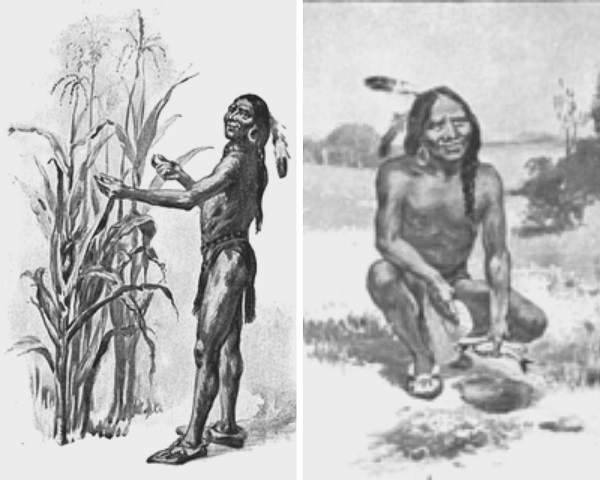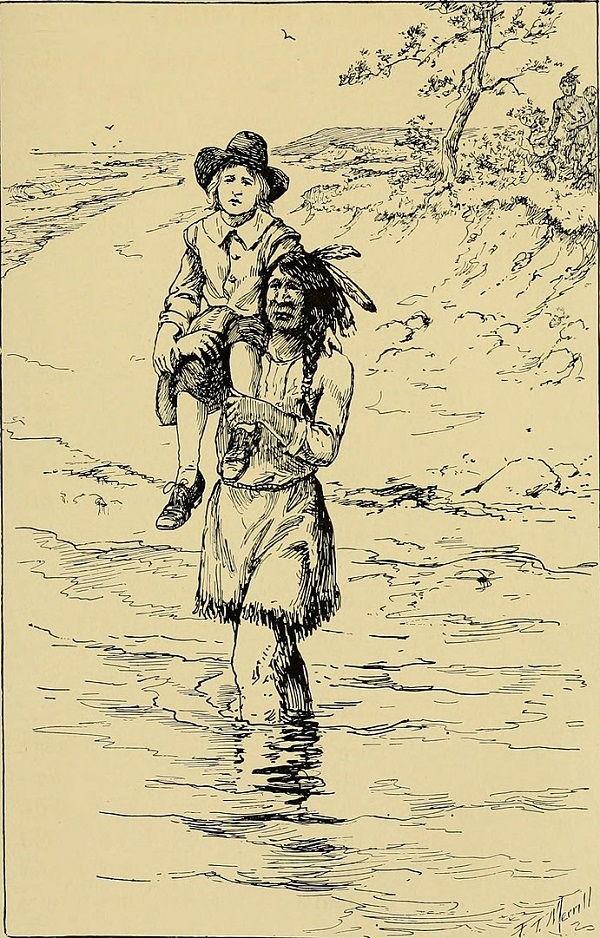Squanto was a Native-American who helped the Mayflower pilgrims survive their first year at Plymouth Colony. Squanto was a member of the Patuxet tribe and was born in a village in modern-day Plymouth, Mass.
The following is a timeline of Squanto’s life:
1580-1600:
- Squanto’s exact date of birth is unknown but it is estimated that he was born sometime between 1580 and 1600 in the village of Patuxet in Plymouth, Mass.
1614:
- In April, Squanto and 26 other Native-Americans are captured in Plymouth, Mass by Captain Thomas Hunt, a lieutenant for Captain John Smith, and taken to Malga, Spain to be sold as a slave.
- Squanto travels to England with Captain John Slaney, treasurer of the Newfoundland Company, whom he is employed by for a number of years.
1616:
- Slaney sends Squanto to work in an English colony at Cuper’s Cove in Newfoundland.
- A deadly epidemic breaks out in the Native-American villages of coastal New England. Squanto is spared because he is overseas.
1618:
- Squanto meets Captain Thomas Dermer in Newfoundland.
- Dermer takes Squanto back to England to meet with Sir Ferdinando Gorges about joining an expedition to New England.
1619:
- In the spring, Gorges sends Squanto to work as an interpreter for Captain Dermer on a trip to New England where they will join Captain Rocraft and trade with local Native Americans.
- In March, Dermer and Squanto arrive in New England and sail along the coast looking for Captain Rocraft. They later meet a ship from Virginia and learn that Rocraft has died.
- In May, Dermer and Squanto discover that Squanto’s village, Patuxet, in Plymouth, Mass, has been wiped out by the epidemic that broke out in 1616. The village is deserted and skeletons litter the ground.

- The expedition continues on to the village of Nemasket where they encounter the Pokanoket tribe who display great anger towards the English, due to being treated badly by an English ship captain a few years before, and Squanto has to persuade them not to harm Dermer.
- In June, Dermer and the crew return to Maine where Squanto leaves the expedition at Sawahquatooke, in modern-day Saco, Maine, to stay with some of the local natives.
- Dermer and his crew continue the expedition without Squanto and are captured by the Pokanoket and Nemasket tribes but escape, taking three natives as hostages, which they ransom back to the tribe.
- The expedition continues on to Martha’s Vineyard where Dermer meets a Nauset leader named Epenow, who had been had previously been enslaved by Gorges in 1611 but escaped and was thought to be dead.
- In September, Dermer reaches Virginia and spends the winter at Jamestown.
1620:
- In May, Dermer leaves Jamestown and returns to New England.
- In June, Dermer makes a second trip to Plymouth, Mass before sailing to Maine.
- Sometime in the summer of 1620, Squanto rejoins the expedition.
- Later in the summer, Dermer returns to Martha’s Vineyard with Squanto where they are attacked by Epenow and his followers because Epenow fears Gorges sent Dermer there to enslave him again. Most of the crew are killed in the attack, Dermer is wounded but escapes to Virginia where he dies of his wounds and Squanto is enslaved by the Nauset.
- In the fall of 1620, the leader of the Nauset and Wampanoag tribes, Massasoit, transfers Squanto from Martha’s Vineyard to the village of Pokanoket where he remains a prisoner.
- In December, the Mayflower pilgrims land at Plymouth and the Wampanoag watch them from a distance throughout the winter, fearing they are there to avenge Dermer’s death.
1621:
- On March 16, Samoset befriends the Mayflower pilgrims.
- On March 22, Samoset introduces Massasoit, Squanto and the rest of the tribe to the pilgrims.
- Massasoit signs a treaty with the pilgrims and agrees to help the colony survive if the pilgrims agree to help protect the Wampanoags from their enemies.
- Massasoit frees Squanto so he can serve as a guide and interpreter for the colony, teaching the pilgrims what they needed to know to survive in New England.
- In the summer, the pilgrims appoint a second Native-American adviser, Hobbamock, possibly to assist Squanto or to keep him in check.
- On June 11, Squanto and a group of colonists embark on a search and rescue mission for a young boy, John Billington, who had wandered away from Plymouth colony and gotten lost.
- On June 12, Squanto and the colonists meet an elderly Native-American woman at Cummaquid, in modern-day Barnstable, who said Captain Thomas Hunt captured her three sons, around the time Squanto was captured in 1614, and she hasn’t seen them since. The pilgrims apologize on behalf of the English and condemn Hunt as a “bad man” and vow they would never treat a native like that. The colonists find John Billington with the Nauset tribe later that day.

- On July 2, Squanto serves as a guide and interpreter on an expedition led by Edward Winslow to visit Massasoit in Pokanoket to ensure that he still honors their treaty.
- On July 4, the expedition arrives in Pokanoket and finds Massasoit absent but he soon returns and welcomes them warmly and confirms that he still honors their treaty.
- On July 6, Winslow and his crew leave Pokanoket to return to Plymouth and send Squanto to the various native villages to seek trading partners for the colonists.
- On August 14, Hobbamock reports to the Plymouth colonists that Squanto has been captured by Corbitant, a local sachem under Massassoit, while they were visiting Nemasket and the pilgrims embark on a rescue mission to save him but find him unharmed.
- On September 18, Squanto and ten Plymouth colonists set out on an expedition to the Massachusetts Bay to trade with the natives there.
- In the fall, the pilgrims hold the First Thanksgiving feast and invite Squanto, Massasoit and 90 Wampanoags to the three-day celebration.
1622:
- In the winter, Squanto begins to manipulate the colonists and the Wampanoags by spreading lies and rumors that each side was planning to attack the other so that they would seek his guidance and give him gifts to persuade him to make peace.
- In April, the Plymouth colonists and the Wampanoags discover Squanto’s lies after he spread a rumor that the Narraganset tribe and the Wampanoag tribe had formed an alliance and were about to attack Plymouth. The colonists send a friendly native to ask Massasoit if the rumor is true, which he confirms is not, and both sides become upset with Squanto for his deception.
- In May, Massasoit sends a message to Plymouth demanding that they either hand Squanto over to them so he could be put to death or they kill him themselves and send back his head. Governor Bradford refuses both options, which angers Massasoit.
- Squanto is shunned by the Wampanoags and he never leaves the pilgrim’s side again and doesn’t venture outside of Plymouth for months.
- In November, Squanto and Bradford embark on a trading expedition aboard a ship called the Swan to a native settlement called Monomoy, near what is now Chatham. Bradford secures eight hogsheads of corn and beans from the natives during the expedition.
- Just before leaving Chatham, Squanto suddenly becomes sick, developing a fever and bleeding from the nose, and he dies there within a few days. Bradford believes Squanto died of natural causes but some historians think he was poisoned by order of Massasoit.
- The pilgrims bury Squanto in an unmarked grave in an unknown location that is believed to be near what is now the historic Nickerson House in Chatham.
Sources:
Bradford, William. Of Plymouth Plantation. Privately Printed, 1856
Winslow, Edward. Good Newes from New England. Applewood Books, 1996.
Winslow, Edward and William Bradford. Mourt’s Relation: A Journal of the Pilgrims at Plymouth. John Kimball Wiggin, 1865.
Burrage, Henry Sweetser. Gorges and the Grant of the Province of Maine, 1622. Printed for the State, 1923.
Prince, Thomas. A Chronological History of New England in the Form of Annals. Vol. 1, Privately Printed, 1887.
“Squanto Indian Guide.” Historical Marker Database, hmdb.org/m.asp?m=159026
“Plymouth Settlement and Tisquantum.” Proceedings of the Massachusetts Historical Society. University Press, 1915. pp. 103 – 118.
Weeks, Alvin Gardner. Massassoit of the Wampanoags. The Plimpton Press, 1919.
